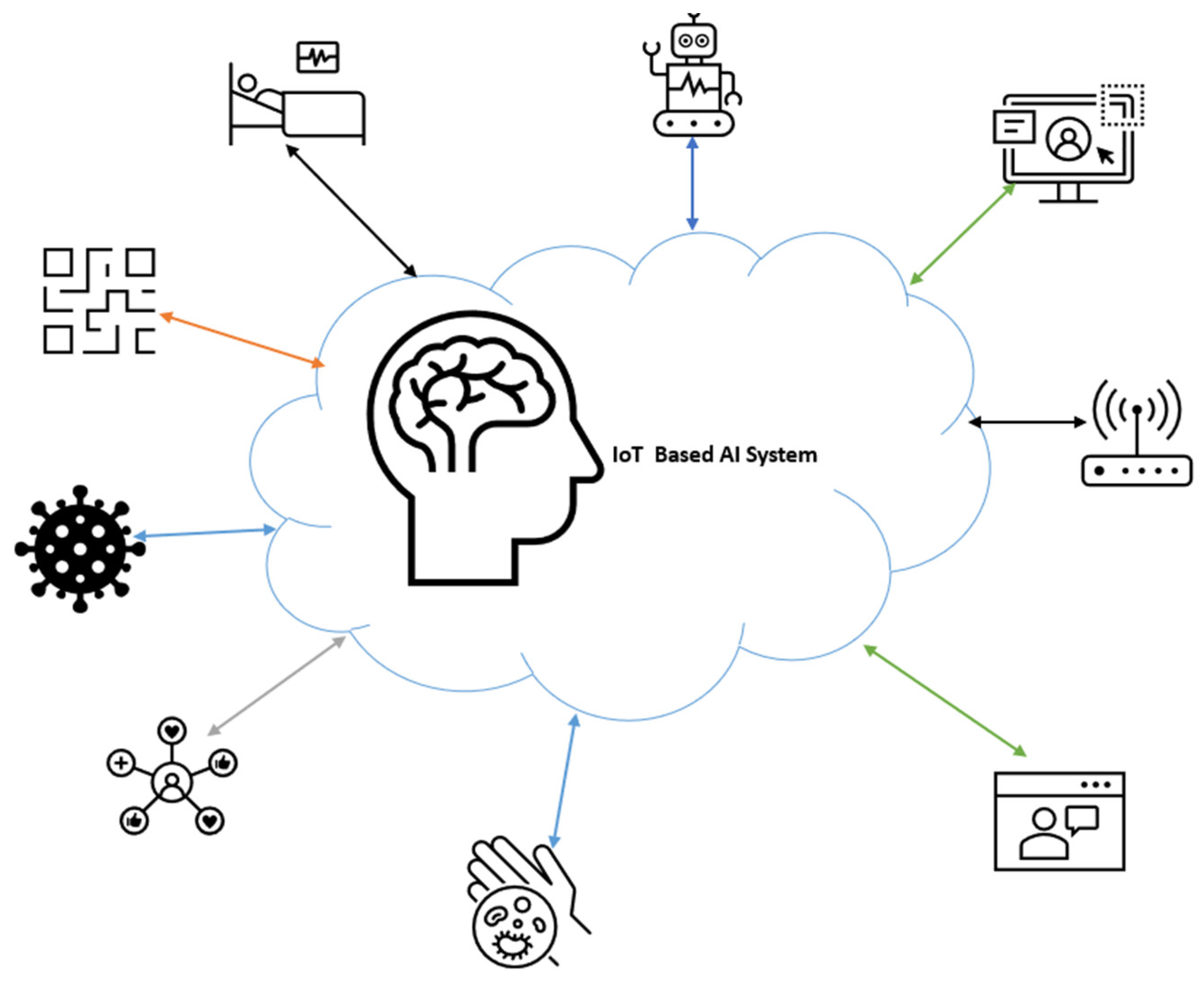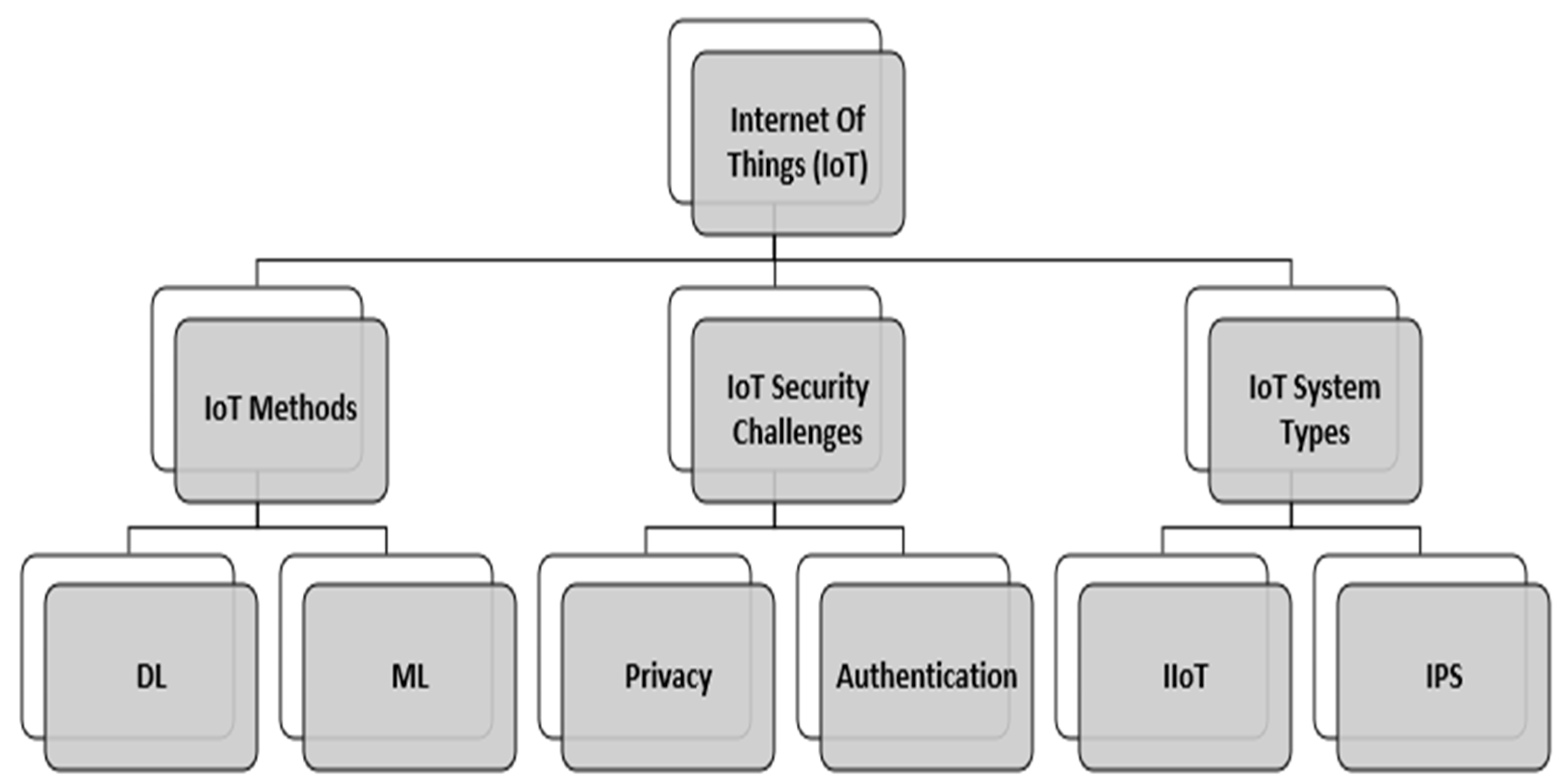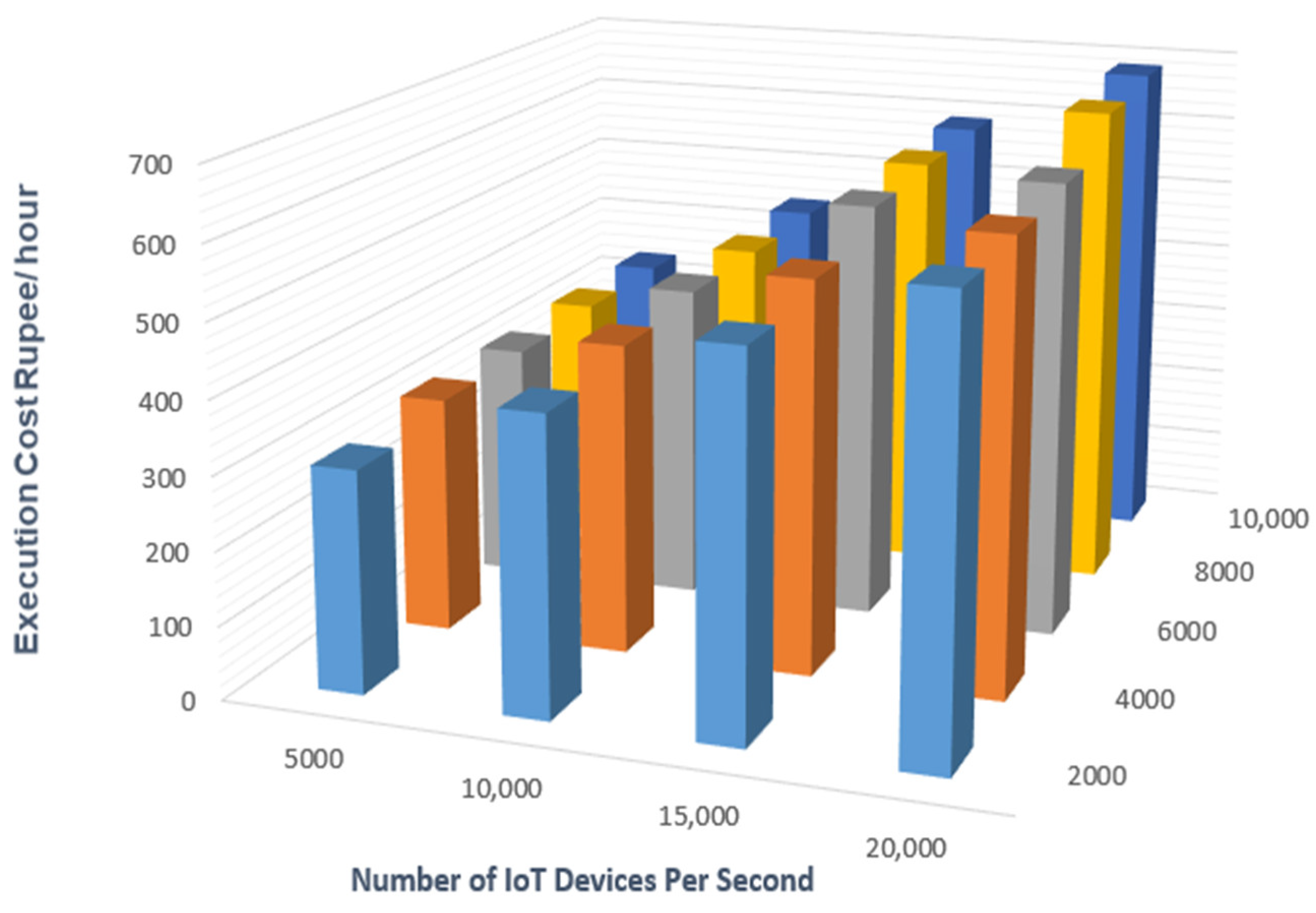Intelligent Machine Learning Based Internet of Things (IoT) Resource Allocation †
Abstract
:1. Introduction
2. State of the Art
3. IoT Applications
4. Parameters Effecting the IoT
| Algorithm 1: The proposed algorithm provides efficient ML for IoT applications |
| Input: The parameters of datasets are counted as the input in the algorithm. Output: The optimized predictions of the messages are found for the end users. 1: Procedure (Methods:) 2: If (IoT Applications = Ø) then 3: { 4: Perform no value of detection. 5: Else Check (IoT Applications is in which Class) 6: { 7: If (IoT Applications = Upper Approximation) then 8: { 9: Apply the Fuzzy optimization system in IoT Applications. Step1: Divide all the classes into functional and nonfunctional properties of classes. 10: else if (IoT Applications = Lower Approximation) Apply the Fuzzy optimization system in IoT Applications. 11: end if 12: Step2: Formulate the different clusters of the lower IoT Applications as rejected. 13: } 14: end if 15: end if 16: end procedure |
5. Evaluation System of IoT Applications
6. Conclusions and Future Work
Author Contributions
Funding
Institutional Review Board Statement
Informed Consent Statement
Data Availability Statement
Conflicts of Interest
References
- Hussain, F.; Hussain, R.; Hassan, S.A.; Hossain, E. Machine learning in IoT security: Current solutions and future challenges. IEEE Commun. Surv. Tutor. 2020, 22, 1686–1721. [Google Scholar] [CrossRef]
- Laghari, A.A.; Wu, K.; Laghari, R.A.; Ali, M.; Khan, A.A. A review and state of art of Internet of Things (IoT). Arch. Comput. Methods Eng. 2021, 29, 1395–1413. [Google Scholar] [CrossRef]
- Al-Masri, E.; Kalyanam, K.R.; Batts, J.; Kim, J.; Singh, S.; Vo, T.; Yan, C. Investigating messaging protocols for the Internet of Things (IoT). IEEE Access 2020, 8, 94880–94911. [Google Scholar] [CrossRef]
- Kumar, S.; Gupta, U.; Singh, A.K.; Singh, A.K. Artificial Intelligence: Revolutionizing Cyber Security in the Digital Era. J. Comput. Mech. Manag. 2023, 2, 31–42. [Google Scholar] [CrossRef]
- Tiwari, A.; Garg, R. Orrs Orchestration of a Resource Reservation System Using Fuzzy Theory in High-Performance Computing: Lifeline of the Computing World. Int. J. Softw. Innov. (IJSI) 2022, 10, 1–28. [Google Scholar] [CrossRef]
- Meneghello, F.; Calore, M.; Zucchetto, D.; Polese, M.; Zanella, A. IoT: Internet of threats? A survey of practical security vulnerabilities in real IoT devices. IEEE Internet Things J. 2019, 6, 8182–8201. [Google Scholar]
- Hassan, W.H. Current research on Internet of Things (IoT) security: A survey. Comput. Netw. 2019, 148, 283–294. [Google Scholar]
- Tiwari, A.; Garg, R. Adaptive Ontology-Based IoT Resource Provisioning in Computing Systems. Int. J. Semant. Internet Inf. Syst. (IJSWIS) 2022, 18, 1–18. [Google Scholar] [CrossRef]
- Waheed, N.; He, X.; Ikram, M.; Usman, M.; Hashmi, S.S.; Usman, M. Security and privacy in IoT using machine learning and blockchain: Threats and countermeasures. ACM Comput. Surv. (CSUR) 2020, 53, 1–37. [Google Scholar] [CrossRef]
- Al-Turjman, F.; Baali, I. Machine learning for wearable IoT-based applications: A survey. Trans. Emerg. Telecommun. Technol. 2022, 33, 3635–3647. [Google Scholar] [CrossRef]
- Tiwari, A.; Garg, R. Reservation System for Cloud Computing Resources (RSCC): Immediate Reservation of the Computing Mechanism. Int. J. Cloud Appl. Comput. (IJCAC) 2022, 12, 1–22. [Google Scholar] [CrossRef]
- Rohinidevi, V.V.; Srivastava, P.K.; Dubey, N.; Tiwari, S.; Tiwari, A. A Taxonomy towards fog computing Resource Allocation. In Proceedings of the 2022 2nd International Conference on Innovative Sustainable Computational Technologies (CISCT), Dehradun, India, 23–24 December 2022; pp. 1–5. [Google Scholar]
- Singh, N.K.; Jain, A.; Arya, S.; Gonzales, W.E.G.; Flores, J.E.A.; Tiwari, A. Attack Detection Taxonomy System in cloud services. In Proceedings of the 2022 2nd International Conference on Innovative Sustainable Computational Technologies (CISCT), Dehradun, India, 23–24 December 2022; pp. 1–5. [Google Scholar]
- Chowdhary, S.K.; Hassan, B.U.; Sharma, T. Monitoring Senior Citizens Using IoT and ML. In Computational Intelligence: Select Proceedings of InCITe; Springer: Singapore, 2023; pp. 777–789. [Google Scholar]
- Kanade, P.; Prasad, J.P. Arduino based machine learning and IOT Smart Irrigation System. Int. J. Soft Comput. Eng. (IJSCE) 2021, 10, 1–5. [Google Scholar] [CrossRef]
- Ravula, A.K.; Ahmad, S.S.; Singh, A.K.; Sweeti, S.; Kaur, A.; Kumar, S. Multi-level collaborative framework decryption-based computing systems. AIP Conf. Proc. 2023, 2782, 96–112. [Google Scholar]
- Rangaiah, Y.V.; Sharma, A.K.; Bhargavi, T.; Chopra, M.; Mahapatra, C.; Tiwari, A. A Taxonomy towards Blockchain based Multimedia content Security. In Proceedings of the 2022 2nd International Conference on Innovative Sustainable Computational Technologies (CISCT), Dehradun, India, 23–24 December 2022; pp. 1–4. [Google Scholar]
- Kamble, S.; Saini, D.K.J.; Kumar, V.; Gautam, A.K.; Verma, S.; Tiwari, A.; Goyal, D. Detection and tracking of moving cloud services from video using saliency map model. J. Discret. Math. Sci. Cryptogr. 2022, 25, 1083–1092. [Google Scholar] [CrossRef]
- Manikandan, R.; Maurya, R.K.; Rasheed, T.; Bose, S.C.; Arias-Gonzáles, J.L.; Mamodiya, U.; Tiwari, A. Adaptive cloud orchestration resource selection using rough set theory. J. Interdiscip. Math. 2023, 26, 311–320. [Google Scholar] [CrossRef]
- Srivastava, P.K.; Kumar, S.; Tiwari, A.; Goyal, D.; Mamodiya, U. Internet of thing uses in materialistic ameliorate farming through AI. AIP Conf. Proc. 2023, 2782, 67–75. [Google Scholar]




Disclaimer/Publisher’s Note: The statements, opinions and data contained in all publications are solely those of the individual author(s) and contributor(s) and not of MDPI and/or the editor(s). MDPI and/or the editor(s) disclaim responsibility for any injury to people or property resulting from any ideas, methods, instructions or products referred to in the content. |
© 2023 by the authors. Licensee MDPI, Basel, Switzerland. This article is an open access article distributed under the terms and conditions of the Creative Commons Attribution (CC BY) license (https://creativecommons.org/licenses/by/4.0/).
Share and Cite
Chakraborty, K.; Kapila, D.; Kumar, S.; Bhupati; Shaik, N.; Singh, A. Intelligent Machine Learning Based Internet of Things (IoT) Resource Allocation. Eng. Proc. 2023, 59, 73. https://doi.org/10.3390/engproc2023059073
Chakraborty K, Kapila D, Kumar S, Bhupati, Shaik N, Singh A. Intelligent Machine Learning Based Internet of Things (IoT) Resource Allocation. Engineering Proceedings. 2023; 59(1):73. https://doi.org/10.3390/engproc2023059073
Chicago/Turabian StyleChakraborty, Koushik, Dhiraj Kapila, Sumit Kumar, Bhupati, Nazeer Shaik, and Akanksha Singh. 2023. "Intelligent Machine Learning Based Internet of Things (IoT) Resource Allocation" Engineering Proceedings 59, no. 1: 73. https://doi.org/10.3390/engproc2023059073
APA StyleChakraborty, K., Kapila, D., Kumar, S., Bhupati, Shaik, N., & Singh, A. (2023). Intelligent Machine Learning Based Internet of Things (IoT) Resource Allocation. Engineering Proceedings, 59(1), 73. https://doi.org/10.3390/engproc2023059073





